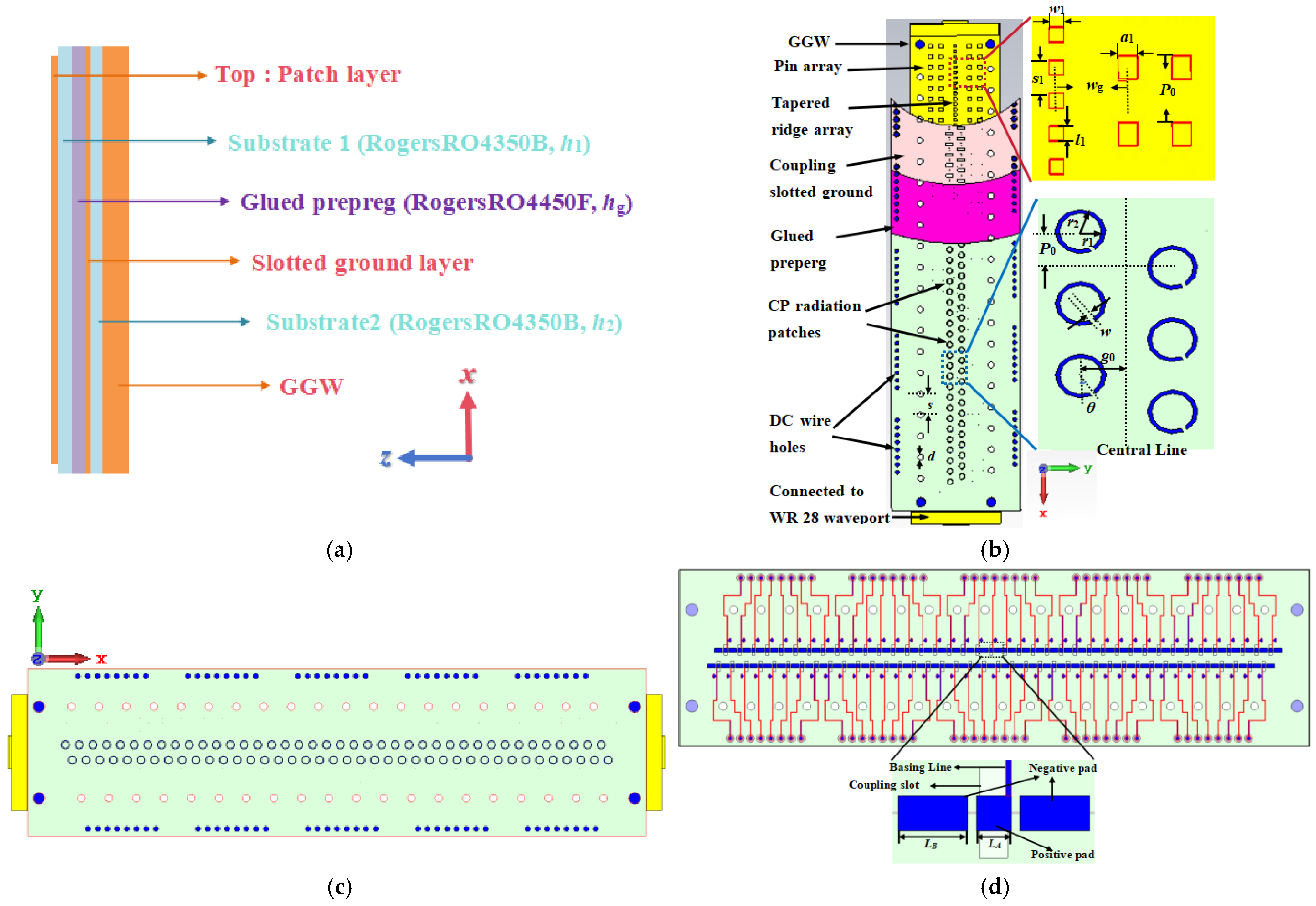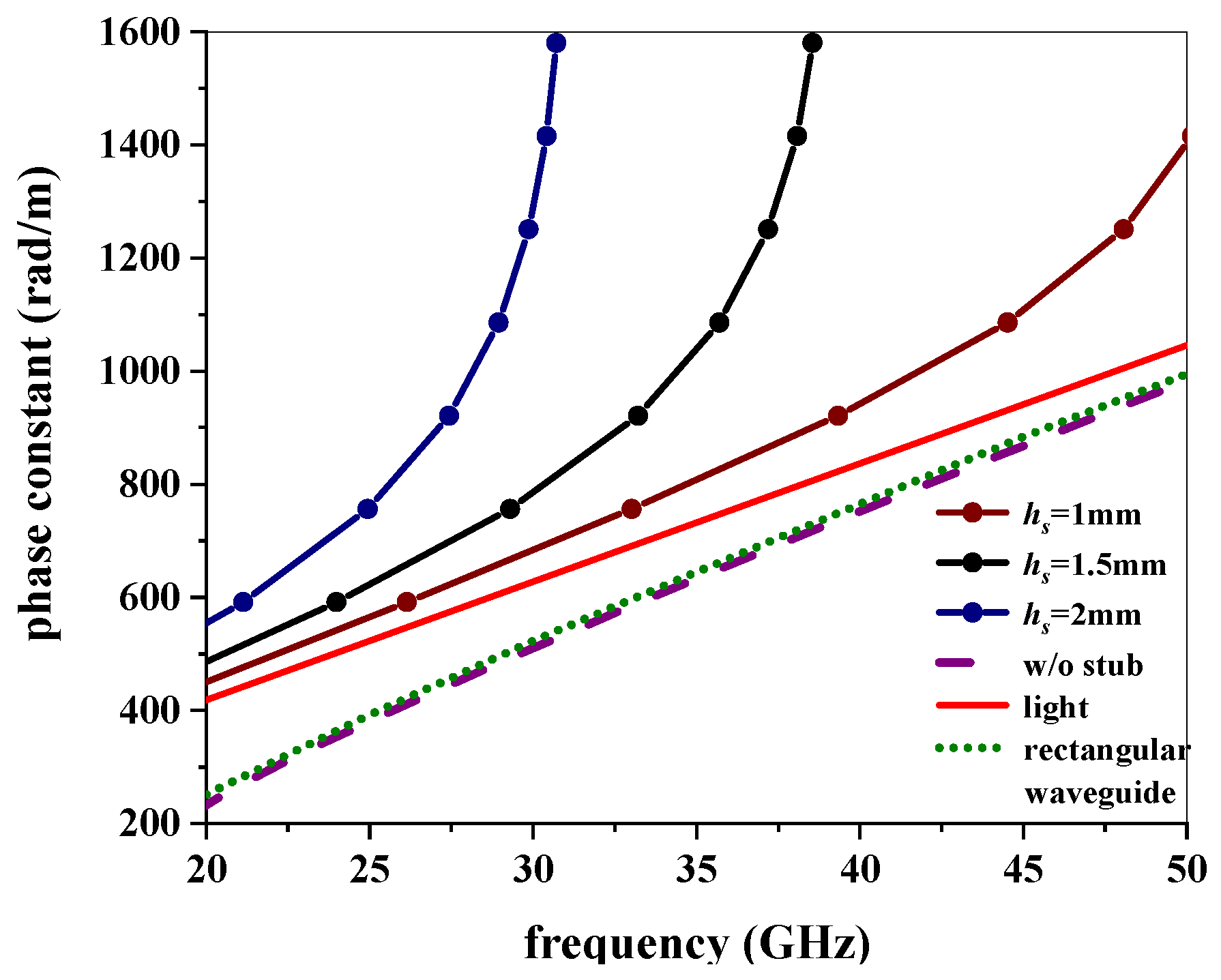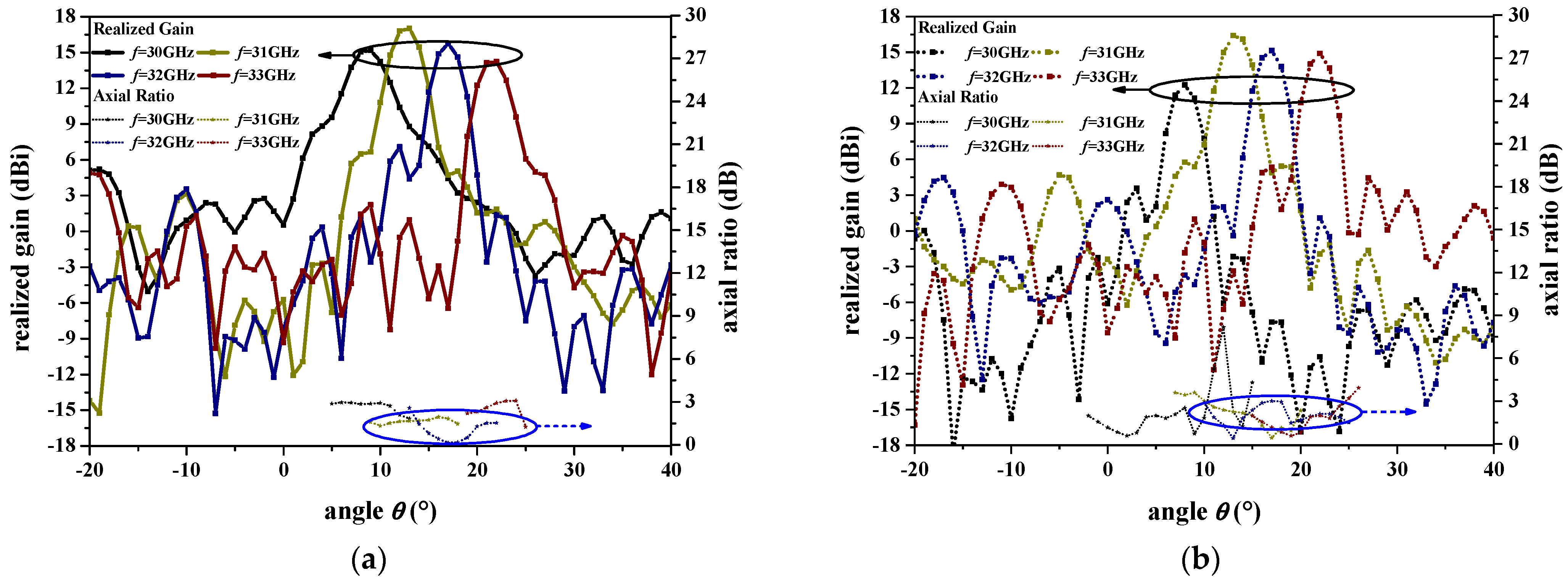A Fixed-Frequency Beam-Scanning Leaky-Wave Antenna with Circular Polarization for mmWave Application
Abstract
:1. Introduction
2. Configuration and Mechanism
3. Simulations and Measurements
4. Conclusions
Author Contributions
Funding
Institutional Review Board Statement
Informed Consent Statement
Data Availability Statement
Conflicts of Interest
References
- Hansen, W.W. Radiating Electromagnetic Waveguide. U.S. Patent 2402622, 25 June 1946. [Google Scholar]
- Jackson, D.R.; Caloz, C.; Itoh, T. Leaky-wave antennas. Proc. IEEE 2012, 100, 2194–2206. [Google Scholar] [CrossRef]
- Sabahi, M.M.; Heidari, A.A.; Movahhedi, M. A compact CRLH circularly polarized leaky-wave antenna based on substrate-integrated waveguide. IEEE Trans. Antennas Propag. 2018, 66, 4407–4414. [Google Scholar] [CrossRef]
- Monticone, F.; Alu, A. Leaky-wave theory, techniques, and applications: From microwaves to visible frequencies. Proc. IEEE 2015, 103, 793–821. [Google Scholar] [CrossRef]
- Liu, J. Periodic leaky-wave antennas based on microstrip-fed slot array with different profile modulations for suppressing open stopband and n = −2 space harmonic. IEEE Trans. Antennas Propag. 2021, 69, 7364–7376. [Google Scholar] [CrossRef]
- Huo, X.; Wang, J.; Li, Z.; Li, Y.; Chen, M.; Zhang, Z. Periodic leaky-wave antenna with circular polarization and low-SLL properties. IEEE Antennas Wireless Propag. Lett. 2018, 17, 1195–1198. [Google Scholar] [CrossRef]
- Zhang, G.; Zhang, Q.; Chen, Y.; Murch, R.D. High-scanning-rate and wide-angle leaky-wave antennas based on glide-symmetry Goubau line. IEEE Trans. Antennas Propag. 2020, 68, 2531–2540. [Google Scholar] [CrossRef]
- Mishra, G.; Sharma, S.K.; Chieh, J.S. A high gain series-fed circularly polarized traveling-wave antenna at W-band using a new butterfly radiating element. IEEE Trans. Antennas Propag. 2020, 68, 7947–7957. [Google Scholar] [CrossRef]
- Zhao, S.; Dong, Y. Circularly polarized beam-steering microstrip leaky-wave antenna based on coplanar polarizers. IEEE Antennas Wirel. Propag. Lett. 2022, 21, 2259–2263. [Google Scholar] [CrossRef]
- Zhang, H.-H.; Li, R.; Ren, J.; Du, X.; Zhang, C.; Sun, X.-Y.; Yin, Y.; Shen, M. High-scanning-rate and wide-scanning-angle leakywave antenna based on double-layer slow-wave structure. IEEE Antennas Wireless Propag. Lett. 2023, 22, 2145–2149. [Google Scholar] [CrossRef]
- Fu, J.-H.; Li, A.; Chen, W.; Lv, B.; Wang, Z.; Li, P.; Wu, Q. An electrically controlled CRLH-inspired circularly polarized leaky-wave antenna. IEEE Antennas Wireless Propag. Lett. 2017, 16, 760–763. [Google Scholar] [CrossRef]
- Wang, M.; Ma, H.F.; Zhang, H.C.; Tang, W.X.; Zhang, X.R.; Cui, T.J. Frequency-fixed beam-scanning leaky-wave antenna using electronically controllable corrugated microstrip line. IEEE Trans. Antennas Propag. 2018, 66, 4449–4457. [Google Scholar] [CrossRef]
- Li, Z.; Guo, Y.J.; Chen, S.L.; Wang, J. A period-reconfigurable leaky-wave antenna with fixed-frequency and wide-angle beam scanning. IEEE Trans. Antennas Propag. 2019, 67, 3720–3732. [Google Scholar] [CrossRef]
- Geng, Y.; Wang, J.; Li, Y.; Li, Z.; Chen, M.; Zhang, Z. Radiation pattern-reconfigurable leaky-wave antenna for fixed-frequency beam steering based on substrate-integrated waveguide. IEEE Antennas Wirel. Propag. Lett. 2019, 18, 387–391. [Google Scholar] [CrossRef]
- Wang, S.; Li, Z.; Chen, M.; Wang, J. A TE01-mode groove-gap-waveguide-based wideband fixed-frequency beam-scanning leaky-wave antenna for millimeter-wave applications. IEEE Trans. Antennas Propag. 2021, 70, 4171–4180. [Google Scholar] [CrossRef]
- Liu, S.; Li, Z.; Wang, J. A fixed-frequency beam-scanning leaky-wave antenna using phase and amplitude control for millimeter-wave applications. IEEE Trans. Antennas Propag. 2022, 71, 1568–1577. [Google Scholar] [CrossRef]
- Wei, B.; Li, Z.; Ma, Y.; Wang, Z.; Wang, J. A Two-Dimensional Fixed-Frequency Beam-Scanning Leaky-Wave Antenna Array for Millimeter-Wave Application. IEEE Trans. Antennas Propag. 2024, 72, 4888–4899. [Google Scholar] [CrossRef]
- Gao, S.; Luo, Q.; Zhu, F. Circularly Polarized Antennas; Wiley: Hoboken, NJ, USA, 2013. [Google Scholar]
- Aljuhani, A.H.; Kanar, T.; Zihir, S.; Rebeiz, G.M. A 256-element Ku-band polarization agile SATCOM receive phased array with wide-angle scanning and high polarization purity. IEEE Trans. Microw. Theory Technol. 2021, 69, 2609–2628. [Google Scholar] [CrossRef]
- Kim, J.-W.; Chae, S.-C.; Jo, H.-W.; Yeo, T.-D.; Yu, J.-W. Wideband circularly polarized phased array antenna system for wide axial ratio scanning. IEEE Trans. Antennas Propag. 2022, 70, 1523–1528. [Google Scholar] [CrossRef]
- Wang, S.; Li, Z.; Wang, J. A Quad-Polarization Reconfigurable Fixed-Frequency Beam-Scanning Leaky-Wave Antenna Based on the Holographic Method for Millimeter-Wave Application. IEEE Trans. Antennas Propag. 2023, 71, 723–733. [Google Scholar] [CrossRef]
- Dimitrov, K.C.; Lee, Y.; Min, B.-W.; Park, J.; Jeong, J.; Kim, H.-J. Circularly polarized T-shaped slot waveguide array antenna for satellite communications. IEEE Antennas Wireless Propag. Lett. 2020, 19, 317–321. [Google Scholar] [CrossRef]
- Agarwal, R.; Yadava, R.L.; Das, S. A multilayered SIW-based circularly polarized CRLH leaky wave antenna. IEEE Trans. Antennas Propag. 2021, 69, 6312–6321. [Google Scholar] [CrossRef]
- Mallioras, I.; Zaharis, Z.D.; Lazaridis, P.I.; Pantelopoulos, S. A novel realistic approach of adaptive beamforming based on deep neural networks. IEEE Trans. Antennas Propag. 2022, 70, 8833–8848. [Google Scholar] [CrossRef]
- Geng, Y.; Wang, J.; Li, Z.; Li, Y.; Chen, M.; Zhang, Z. A compact circularly polarized half-mode substrate integrated waveguide-based leaky-wave antenna array with wide range of dual-beam scanning. Int. J. RF Microw. Comput. Aided Eng. 2022, 32, e23074. [Google Scholar] [CrossRef]
- Cheng, Y.J.; Hong, W.; Wu, K. Millimeter-wave half mode substrate integrated waveguide frequency scanning antenna with quadri-polarization. IEEE Trans. Antennas Propag. 2010, 58, 1848–1855. [Google Scholar] [CrossRef]
- Liao, Q.; Wang, L. Switchable bidirectional/unidirectional LWA array based on half-mode substrate integrated waveguide. IEEE Antennas Wirel. Propag. Lett. 2020, 19, 1261–1265. [Google Scholar] [CrossRef]
- Geng, Y.; Wang, J.; Li, Y.; Li, Z.; Chen, M.; Zhang, Z. A Ka-band leaky-wave antenna array with stable gains based on HMSIW structure. IEEE Antennas Wirel. Propag. Lett. 2022, 21, 1597–1601. [Google Scholar] [CrossRef]
- Liu, Y.Q.; Zhu, Y.; Wang, Y.; Ren, Z.; Yin, H.; Qi, K.; Sun, J. Monolithically integrated wide field-of-view metalens by angular dispersionless metasurface. Mater. Des. 2024, 240, 112879. [Google Scholar] [CrossRef]









| N | Operation States | Period Length | θn |
|---|---|---|---|
| 1 | 10010010010010010010010010010010010010010010010010010010010010010010010010010010 | P = 3P0 | −13° |
| 2 | 11001100110011001100110011001100110011001100110011001100110011001100110011001100 | P = 4P0 | −8° |
| 3 | 11001100011000110001100110001100011000110011000110001100011001100011000110001100 | P = 4.75P0 | 0° |
| 4 | 11000110001100011000110001100011000110001100011000110001100011000110001100011000 | P = 5P0 | 13° |
| 5 | 11100011100001110001110000111000111000011100011100001110001110000111000111000011 | P = 6.5P0 | 21° |
| 6 | 11110000111100001111000011110000111100001111000011110000111100001111000011110000 | P = 8P0 | 32° |
| 7 | 11111100000011111100000011111100000011111100000011111100000011111100000011111100 | P = 12P0 | 48° |
| Ref. | Frequency (GHz) | Bean-Scanning Range | Peak Gain (dBi) | Polarization |
|---|---|---|---|---|
| [25] | 5.2–6.9 | −62° to 0° | 13.5 | Circular polarization |
| [26] | 33–39 | −30° to 3° | 14.85 | Quadri-polarization |
| [27] | 12–14 | −30° to 59° | 15.95 | Linear polarization |
| [28] | 27–40 | −40° to 30° | 15 | Linear polarization |
| [29] | 9.5 | −40° to 40° | - | Single polarization |
| This work | 26–38 | −13° to 48° | 17.1 | Circular polarization |
Disclaimer/Publisher’s Note: The statements, opinions and data contained in all publications are solely those of the individual author(s) and contributor(s) and not of MDPI and/or the editor(s). MDPI and/or the editor(s) disclaim responsibility for any injury to people or property resulting from any ideas, methods, instructions or products referred to in the content. |
© 2025 by the authors. Licensee MDPI, Basel, Switzerland. This article is an open access article distributed under the terms and conditions of the Creative Commons Attribution (CC BY) license (https://creativecommons.org/licenses/by/4.0/).
Share and Cite
Huo, X.; Ma, Y.; Liu, J.; Zhou, Q. A Fixed-Frequency Beam-Scanning Leaky-Wave Antenna with Circular Polarization for mmWave Application. Photonics 2025, 12, 274. https://doi.org/10.3390/photonics12030274
Huo X, Ma Y, Liu J, Zhou Q. A Fixed-Frequency Beam-Scanning Leaky-Wave Antenna with Circular Polarization for mmWave Application. Photonics. 2025; 12(3):274. https://doi.org/10.3390/photonics12030274
Chicago/Turabian StyleHuo, Xingying, Yuchen Ma, Jiayi Liu, and Qinghuai Zhou. 2025. "A Fixed-Frequency Beam-Scanning Leaky-Wave Antenna with Circular Polarization for mmWave Application" Photonics 12, no. 3: 274. https://doi.org/10.3390/photonics12030274
APA StyleHuo, X., Ma, Y., Liu, J., & Zhou, Q. (2025). A Fixed-Frequency Beam-Scanning Leaky-Wave Antenna with Circular Polarization for mmWave Application. Photonics, 12(3), 274. https://doi.org/10.3390/photonics12030274





